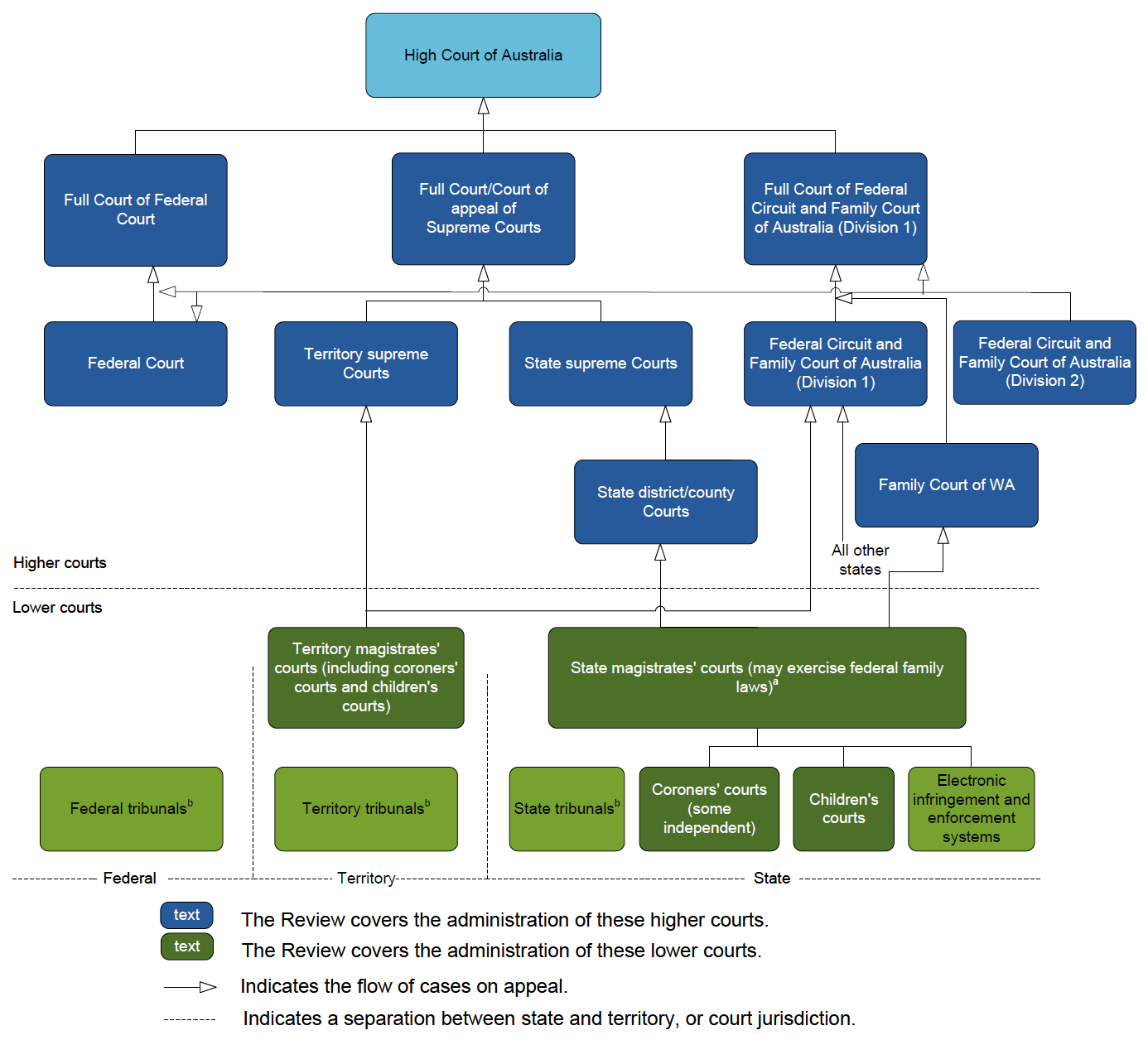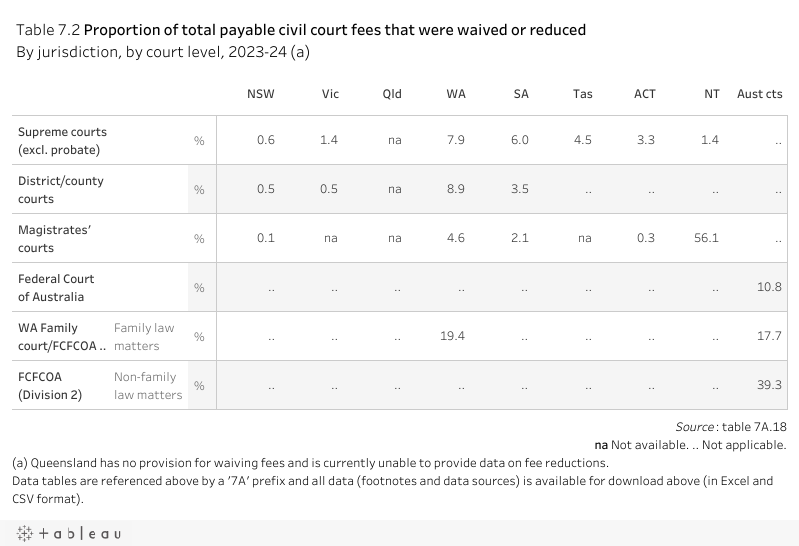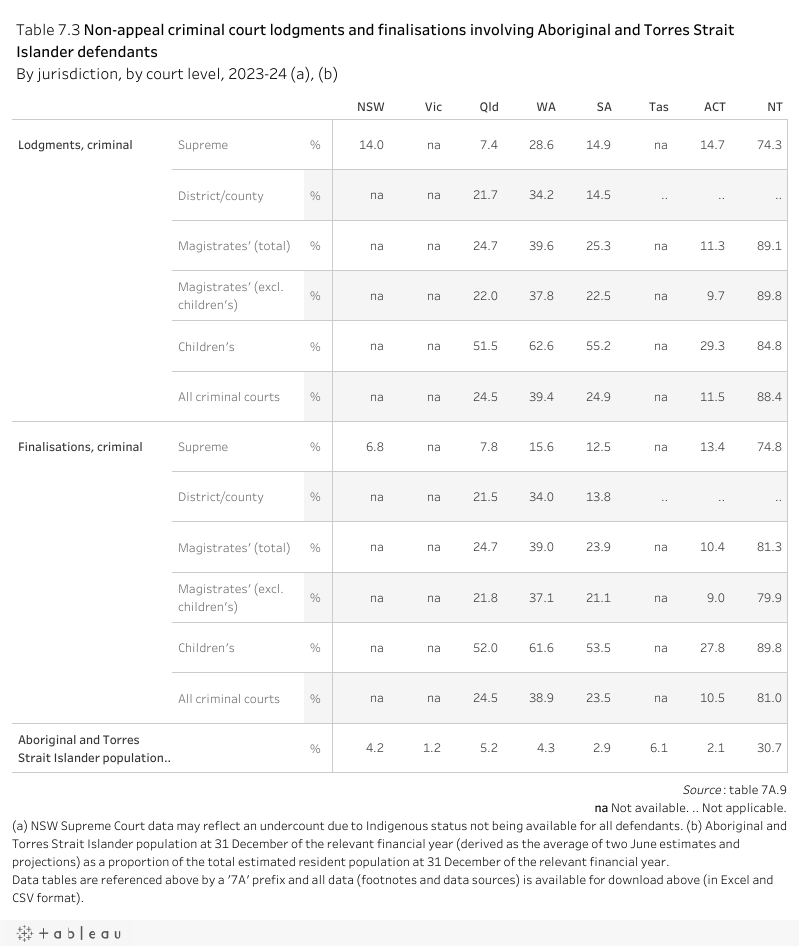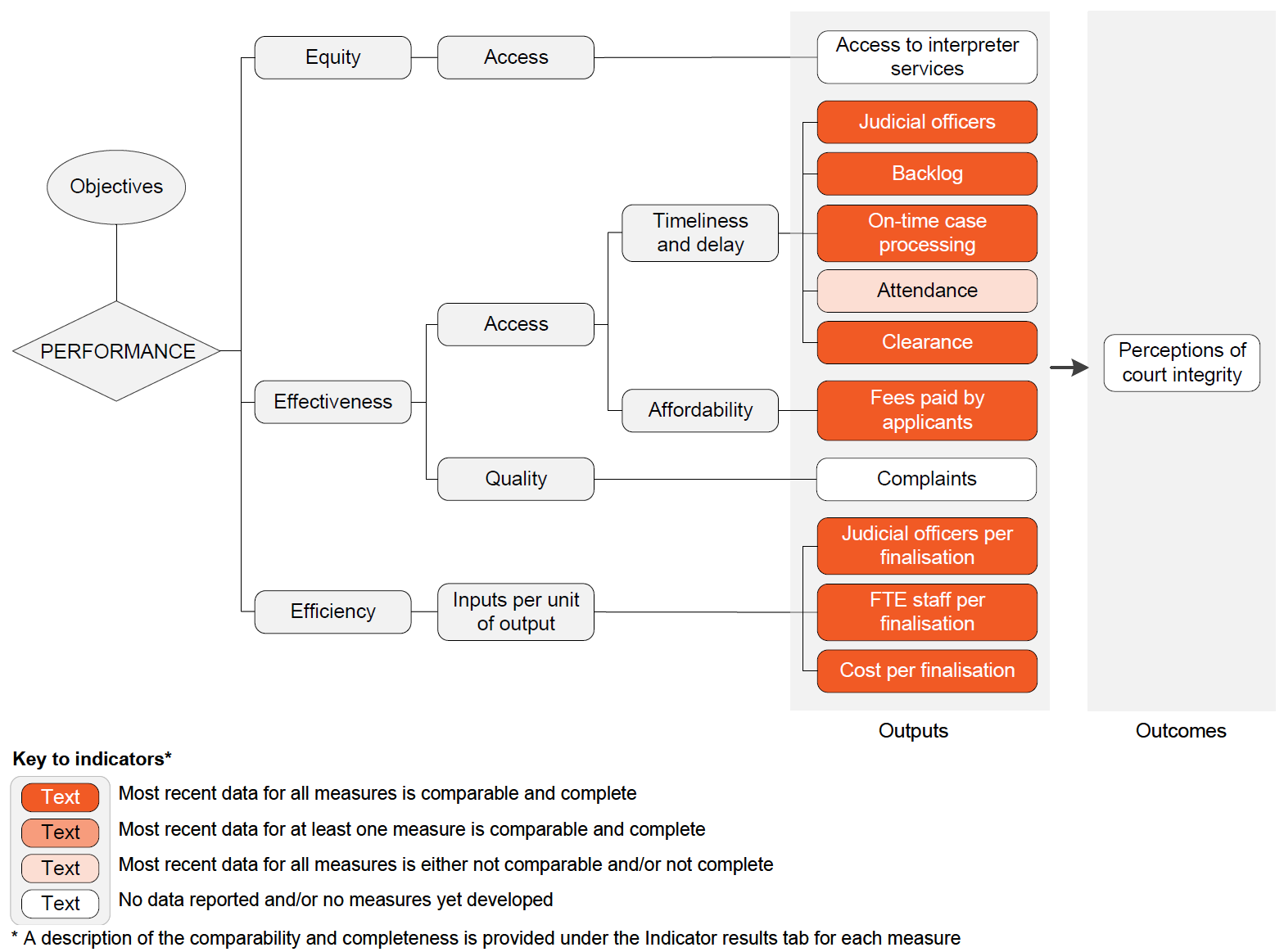WORKING GROUP DRAFT – IN CONFIDENCEReport on Government Services 2026
PART C, SECTION 7: RELEASED ON 3 FEBRUARY 2026
7 Courts
The focus of this section is the court administration functions of Australian and state and territory courts.
Data is reported for the Federal Court of Australia, the Federal Circuit and Family Court of Australia (Division 1), the Federal Circuit and Family Court of Australia (Division 2), the criminal and civil jurisdictions of the supreme courts (including probate registries), district/county courts, magistrates' courts (including children's courts), coroners' courts and the Family Court of Western Australia.
The Indicator results tab uses data from the data tables to provide information on the performance for each indicator in the Indicator framework. The same data in the data tables are also available in CSV format.
Data downloads
![]() 7 Courts data tables (XLSX 648.9 KB)
7 Courts data tables (XLSX 648.9 KB)
Refer to the corresponding table number in the data tables for detailed definitions, caveats, footnotes and data source(s).
Objectives for courts
Courts aim to safeguard and maintain the rule of law and ensure equal justice for all. Court services support the courts and aim to encourage public confidence and trust in the courts by enabling them to:
- be open and accessible
- be affordable
- process matters in a high quality, expeditious and timely manner.
Governments aim for court services to meet these objectives in an equitable and efficient manner.
The primary support functions of court administration services are to:
- manage court facilities and staff, including buildings, security and ancillary services such as registries, libraries and transcription services
- provide case management services, including client information, scheduling and case flow management
- enforce court orders through the sheriff’s department or a similar mechanism.
Court support services are reported for the State and Territory supreme, district/county and magistrates’ (including children’s) courts, coroners’ courts and probate registries, and for the Federal Court of Australia, the Federal Circuit and Family Court of Australia (Divisions 1 and 2), and the Family Court of Western Australia.
The High Court of Australia, tribunals and specialist jurisdiction courts (for example, Indigenous courts, circle sentencing courts, drug courts and electronic infringement and enforcement systems) are excluded.
State and territory court levels
There is a hierarchy of courts within each state and territory (refer to figure 7.1). Supreme courts hear disputes of greater seriousness than those heard in the other courts. Supreme courts also develop the law and operate as courts of judicial review or appeal. For the majority of states and territories, the hierarchy of courts is as outlined below (although Tasmania, the Australian Capital Territory and the Northern Territory do not have a district/county court):
- supreme courts (includes probate)
- district/county courts
- magistrates’ courts (includes children’s and coroners’ courts).
Differences in state and territory court levels mean that the allocation of cases to courts and seriousness of cases heard varies across states and territories.
Supreme court jurisdictions across states and territories
Criminal courts
All state and territory supreme courts have jurisdiction over similar criminal matters such as murder, treason and certain serious drug offences, but significant differences exist in this court level across the states and territories:
- District/county courts do not operate in Tasmania, the Australian Capital Territory and the Northern Territory, instead the supreme courts generally exercise a jurisdiction equal to that of both the supreme and district/county courts in other states.
- The Queensland Supreme Court deals with a number of drug matters, which supreme courts in other states and territories do not hear.
- In the New South Wales Supreme Court, almost all indictments are for offences of murder and manslaughter, whereas the range of indictments routinely presented in most other states and territories is broader.
- In the Western Australian Supreme Court, with the introduction of the Court Jurisdiction Legislation Amendment Act 2018 which came into effect on 1 January 2019, the Court predominantly deals with the most serious offences such as homicide and related offences, and serious breaches of Commonwealth drug enforcement laws.
All state and territory supreme courts hear appeals, but the number and type of appeals vary because in New South Wales, Victoria and Queensland some appeals are also heard in district/county courts.
Civil courts
All supreme courts deal with appeals and probate applications and have an unlimited jurisdiction on claims but:
- New South Wales usually deals with complex cases, all claims over $750,000 (except claims related to motor vehicle accidents or worker's compensation) and various other civil matters.
- Victoria deals with complex cases, high value claims and various other civil matters.
- Queensland deals with claims over $750,000 and administrative law matters.
- Western Australia usually deals with claims over $750,000.
- South Australia exercises its unlimited jurisdiction for general and personal injury matters.
- Tasmania usually deals with claims over $50,000.
- The Australian Capital Territory usually deals with claims over $250,000.
- The Northern Territory also deals with mental health, family law and Coroners Act 1993 applications.
District/county court jurisdictions across states and territories
There are no district/county courts in Tasmania, the Australian Capital Territory or the Northern Territory.
Criminal courts
The district/county courts have jurisdiction over indictable criminal matters (such as rape and armed robbery) except murder and treason, but differences exist among the states that have a district/county court. For example, appeals from magistrates' courts are heard in the district/county courts in New South Wales, Victoria and Queensland, but not in Western Australia and South Australia. In the latter two states, all appeals from the magistrates’ court (criminal) go directly to the Supreme court. Briefly, the jurisdictions of the district/county courts are:
- New South Wales: The District Court deals with most of the serious criminal cases that come before the courts. It has responsibility for indictable criminal offences that are normally heard by a judge and jury, but on occasions by a judge alone. It does not deal with treason or murder.
- Victoria: The County Court deals with all indictable offences, except the following which must be heard in the Supreme court: murder, attempted murder, child destruction, certain conspiracy charges, treason, and concealing an offence of treason. Examples of criminal offences heard in the County Court include drug trafficking, serious assaults, serious theft, rape and obtaining financial advantage by deception.
- Queensland: The District Court deals with more serious criminal offences than heard by the Magistrates' Court – for example, rape, armed robbery and fraud.
- Western Australia: With the introduction of the Court Jurisdiction Legislation Amendment Act 2018, which came into effect on 1 January 2019, the District Court has had jurisdiction for all indictable offences (and therefore the ability to impose a range of life imprisonment sentences) except those related to Murder, Manslaughter, attempt to unlawfully kill, assisted suicide etc, and selected Commonwealth offences – these are dealt with by the Supreme Court.
- South Australia: The District Court is the principal trial court and has jurisdiction to try a charge of any offence except treason or murder or offences related to those charges. Almost all matters have been referred following a committal process in the Magistrates Court.
Civil courts
All district/county courts hear appeals and deal with the following types of cases:
- New South Wales: claims up to $750,000 (or more if the parties consent) and has unlimited jurisdiction in motor accident injury claims.
- Victoria: appeals under the Family Violence Protection Act 2008, adoption matters and change-of-name applications. Has unlimited jurisdiction in both personal injury claims and other claims.
- Queensland: claims between $150,000 and $750,000.
- Western Australia: claims up to $750,000 and unlimited claims for personal injuries and has exclusive jurisdiction for motor accident injury claims.
- South Australia: unlimited claims for general and personal injury matters.
Magistrates’ court jurisdictions across states and territories
Criminal courts
- New South Wales: deals summarily with matters with a maximum penalty of up to two years' imprisonment for a single offence, and up to five years' imprisonment for multiple offences, including some indictable offences.
- Victoria: deals with summary offences and determines some indictable offences summarily.
- Queensland: deals with summary offences and determines summarily some indictable matters where the penalty imposed by this jurisdiction may be up to three years imprisonment.
- Western Australia: deals with summary offences and determines some indictable offences summarily.
- South Australia: deals with matters with a maximum penalty of up to five years imprisonment for a single offence and 10 years imprisonment for multiple offences. Magistrates are able to sentence a defendant in relation to certain major indictable offences where the Director of Public Prosecutions (DPP) and defence agree to the defendant being sentenced in the Magistrates' Court.
- Tasmania: deals with matters with a maximum penalty of up to two years imprisonment for a single offence and up to five years imprisonment for a second or subsequent offence. Also deals with some indictable offences summarily.
- Australian Capital Territory: deals summarily with matters with a maximum penalty of up to two years imprisonment. With the DPP's consent, an offence punishable by imprisonment for longer than two years but up to five years. With a defendant's consent, matters with a maximum penalty of up to 14 years imprisonment where the offence relates to money or property (up to 10 years in other cases).
- Northern Territory: deals with some drug and fraud charges and matters with a maximum penalty of up to 10 years imprisonment (or 10–14 years imprisonment if the accused consents).
Civil courts
- New South Wales: deals with small claims up to $20,000 and general division claims up to $100,000, as well as family law matters.
- Victoria: deals with claims up to $100,000 for monetary damages, and applications for equitable relief and applications under the Family Violence Protection Act 2008 and Personal Safety Intervention Orders Act 2010.
- Queensland: deals with claims up to $150,000. Since 1 November 2010 minor civil disputes are lodged with the Queensland Civil and Administrative Tribunal.
- Western Australia: deals with claims for debt recovery and damages (not personal injury) up to $75,000, minor cases up to $10,000, residential tenancy applications for monies up to $10,000, residential tenancy disputes and restraining orders.
- South Australia: deals with minor civil claims up to $12,000, and all other claims including commercial cases and personal injury claims up to $100,000.
- Tasmania: deals with claims up to $50,000 (or more if both parties consent) for monetary damages and debt recovery, minor civil claims up to $5,000, residential tenancy disputes, restraint orders and family violence orders.
- Australian Capital Territory: deals with claims between $25,000 and $250,000, victims' financial assistance applications up to $50,000, matters under the Domestic Relationships Act 1994 and commercial leasing matters. Until December 2016, small claims up to $10,000 were dealt with by the ACT Civil and Administrative Tribunal. From December 2016 the ACT Civil and Administrative Tribunal has had jurisdiction for small claims up to $25,000.
- Northern Territory: deals with claims up to $100,000 and workers compensation claims.
State and territory courts – specific elements
The datasets from the following areas are reported separately from their court level to improve comparability and understanding of the data presented.
Probate
In all states and territories, probate issues are heard in supreme courts and encompass applications for the appointment of an executor or administrator to the estate of a deceased person. The two most common types of application are:
- where the executor nominated by a will applies to have the will proved
- where the deceased was intestate (died without a will) and a person applies for letters of administration to be entitled to administer the estate.
Children’s courts
Children's courts are specialist jurisdiction courts which sit within magistrates' courts. Depending on the state or territory legislation, children's courts may hear both criminal and civil matters. These courts in the main deal with summary proceedings, however some jurisdictions have the power to also hear indictable matters.
Children's courts deal with complaints of offences alleged to have been committed by young people. In all states and territories, children aged under 10 years cannot be charged with a criminal offence. People aged under 18 years at the time the offence was committed are considered a child or juvenile in all states and territories. In February 2018, the Youth Justice and Other Legislation (Inclusion of 17-year-old Persons) Amendment Act 2016 commenced in Queensland, increasing the age that a person can be charged as an adult from 17 to 18 years. This brought Queensland in line with all other Australian states and territories.
Children's courts may also hear matters where a child has been seriously abused or neglected. In these instances, the court has jurisdiction to determine matters relating to the child's care and protection. The majority of matters heard in the civil jurisdiction of children's courts are care and protection orders, although some jurisdictions also hear matters such as applications for intervention orders. In Tasmania, child protection matters are lodged in the criminal registry.
Coroners’ courts
In all states and territories, coroners' courts (which generally operate under the auspices of state and territory magistrates' courts) inquire into the cause of sudden and/or unexpected reported deaths. The definition of a reported death differs across states and territories, but generally includes deaths for which the cause is violent, suspicious or unknown. All coronial jurisdictions investigate deaths in accordance with their respective Coroners Act. Each Act defines what constitutes a 'reportable death' to determine which deaths must be investigated by a coroner. In some states and territories, the coroner has the power to commit for hearing, while in others the coroner is prohibited from making any finding of criminal or civil liability (but may refer the matter to the DPP). Suspicious fires are generally within the jurisdiction of the coroners' courts in New South Wales, Victoria, Tasmania and the Australian Capital Territory but not in the other states and territories. In 2015-16, the scope of fires captured by the ACT Coroners' Act changed, which resulted in a substantial reduction in the number of fires reported to the coroner in the Australian Capital Territory.
Australian court levels
Australian courts hear and determine civil matters arising under laws made by the Australian Government. The hierarchy of Australian courts (refer to figure 7.1) is as follows:
- the High Court of Australia
- the Federal Court
- the Federal Circuit and Family Court of Australia (Division 1)
- the Federal Circuit and Family Court of Australia (Division 2).
Figure 7.1 Major relationships of courts in Australia a

a In some jurisdictions, appeals from lower courts or district/county courts may go directly to the full court or court of appeal at the supreme/federal level; appeals from the Federal Circuit Court can also be heard by a single judge exercising the Federal/Family Courts’ appellate jurisdiction. b Appeals from federal, state and territory tribunals may go to any higher court in their jurisdiction.
Australian Government courts
On 1 September 2021, the Family Court of Australia and Federal Circuit Court of Australia were renamed as the Federal Circuit and Family Court of Australia (Division 1) (FCFCOA (Division 1)) and the Federal Circuit and Family Court of Australia (Division 2) (FCFCOA (Division 2)) respectively. The Federal Court of Australia, the Federal Circuit and Family Court of Australia (Division 1) and the Federal Circuit and Family Court of Australia (Division 2) are, for the purposes of the Public Governance, Performance and Accountability Act 2013, a single listed entity known as the Federal Court of Australia. The administrative arrangements for the two courts have been harmonised under a single, consistent structure. The FCFCOA (Division 1) deals only with family law matters while the FCFCOA (Division 2) deals with family law, migration and other general federal law matters. Since 1 September 2021, the FCFCOA (Division 2) is the single point of entry for all family law applications filed in the federal family law courts (including applications for final orders, associated interim orders, consent orders and applications for divorce).
Federal Court of Australia
The Federal Court has jurisdiction to hear and determine any civil matter arising under laws made by the Federal Parliament, as well as any matter arising under the Constitution or involving its interpretation. The Federal Court also has original jurisdiction in respect of specific subject matter conferred by 240 statutes of the Federal Parliament. It sits in all capital cities on a continuous basis and elsewhere in Australia from time to time.
The Federal Court has a substantial and diverse appellate jurisdiction. It hears appeals from decisions of single judges of the Federal Court, decisions of the FCFCOA (Division 2) in non‑family law matters, decisions of the Supreme Court of Norfolk Island and particular decisions of State and Territory supreme courts exercising federal jurisdiction. Non‑appeal matters for the Federal Court include a significant number of Native Title matters which by nature are both long and complex.
The Federal Court has the power to exercise indictable criminal jurisdiction for serious cartel offences under the Competition and Consumer Act 2010 (formerly the Trade Practices Act). The Federal Court also exercises a very small summary criminal jurisdiction, but the cases are not separately counted. There are so few cases, these would not make a material difference by being included in the civil case totals.
Federal Circuit and Family Court of Australia (Division 1)
The FCFCOA (Division 1) has first instance jurisdiction in all states and territories except Western Australia (which has its own family court). It has jurisdiction to deal with matrimonial cases and associated responsibilities, including divorce proceedings, financial issues and children’s matters such as who the children will live with, spend time with and communicate with, as well as other specific issues relating to parental responsibilities. It can also deal with ex-nuptial cases involving children’s matters. The most complex disputes are heard in the FCFCOA (Division 1).
The FCFCOA (Division 1) has appellate jurisdiction and hears all family law appeals from the FCFCOA (Division 1), FCFCOA (Division 2), the Family Court of Western Australia, and other state and territory courts exercising original jurisdiction in family law.
Family Court of Western Australia
The Family Court of Western Australia was established in 1976 as a state court exercising both state and federal jurisdiction. The Court deals primarily with disputes arising out of relationship breakdowns. It comprises judges, family law magistrates and registrars. Funding for the court is principally sourced through a grant from the Australian Government, which is provided annually to the Western Australian Government. The Western Australian Government provides limited funding for proceedings brought under State legislation dealing with property disputes between de facto couples.
The FCFCOA (Division 1) hears appeals involving the federal family law jurisdiction. In relation to the exercise of non-federal family law jurisdiction (pursuant to the Family Court Act 1997 (WA)) appeals are heard in the Court of Appeal of the Supreme Court of Western Australia.
Federal Circuit and Family Court of Australia (Division 2)
Since 1 September 2021, the FCFCOA (Division 2) is the single point of entry for all family law applications filed in the federal family law courts (including applications for final orders, associated interim orders, consent orders, and applications for divorce). As a result, the vast majority of family law applications continue to be case managed and heard in the FCFCOA (Division 2). The Court now also undertakes a triage function to ensure the most legally and/or factually complex cases are transferred to the FCFCOA (Division 1) for hearing.
The jurisdiction of the FCFCOA (Division 2) is broad and includes a number of varied and complex areas including family law and child support, administrative law, admiralty, anti-terrorism, bankruptcy, copyright, human rights, industrial, migration, privacy and trade practices.
Information on the manner in which court authorities value and treat assets is provided in table 7.12.
Nationally in 2023-24, total recurrent expenditure (excluding payroll tax) by Australian, state and territory courts in this report was approximately $2.67 billion (table 7.1). Expenditure in some states and territories is apportioned (estimated) between the criminal and civil jurisdictions of courts so caution should be used when comparing criminal and civil expenditure across states and territories.
Total recurrent expenditure less court income (excluding payroll tax) for the Australian, state and territory courts in this report was $2.19 billion in 2023-24 (tables 7A.14−15). Court income is derived from court fees, library revenue, court reporting revenue, sheriff and bailiff revenue, probate revenue, mediation revenue, rental income and any other sources of revenue (excluding fines). The civil jurisdiction of courts accounts for the vast majority of income received (table 7A.13).
Cost recovery and fee relief in the civil courts
Court fees are mainly collected in civil courts and in some jurisdictions are set by government rather than court administrators. The level of cost recovery from the collection of civil court fees varies across court levels and states and territories. Nationally, in 2023-24, 26.7% of costs were recovered through court fees in the Supreme courts, 19.4% in the Federal court, 44.3% in the District courts and 17.9% in the Magistrates’ courts (table 7A.16). Cost recovery tends to be low in the children’s courts – in these courts many applications do not attract a fee.
Most courts in Australia are able to waive or reduce court fees to ameliorate the impact on vulnerable or financially disadvantaged parties (fee relief). Table 7.2 shows that the proportions of total payable civil court fees which were waived or reduced in 2023-24 were highest in the Northern Territory Magistrates' court (56.1%) followed by the FCFCOA (Division 2) (39.3%) and the Family Court of Western Australia (19.4%).

Fee exemptions are also available in some courts – this is usually where legislation exists to exempt particular categories of fees from being payable. Fee exemptions are more common in the Federal courts than state and territory courts (table 7A.19).
During 2023-24, almost $42.7 million of civil court fees were either waived, reduced or exempted and therefore not recovered by courts (table 7A.19).
Staffing
Descriptive information on the numbers of judicial officers and full time equivalent staff can be found in tables 7A.28–30.
Lodgments
Lodgments are matters initiated in the court system and provide the basis for court workload as well as reflecting community demand for court services (refer to tables 7A.1–2 for further information).
State and territory courts
Nationally, there were 720,335 criminal lodgments registered in the supreme, district/county, magistrates’ and children’s courts in 2023-24 (table 7A.1). There was a decrease in criminal lodgments from 2022-23 across all states and territories except Western Australia and Tasmania.
Nationally, there were 406,862 civil lodgments (table 7A.2). An additional 93,001 probate matters were lodged in the supreme courts (table 7A.2).
In the coroners’ courts, there were 29,490 deaths and 45 fires reported, with numbers varying across jurisdictions as a result of different reporting requirements (table 7A.2). There were an additional 13,735 lodgments in the Family Court of Western Australia.
There were more lodgments in the criminal courts than civil courts in all states and territories (figure 7.2). Most criminal and civil matters in Australia in 2023-24 were lodged in magistrates’ courts (refer to figure 7.2). The number of lodgments per 100,000 people can assist in understanding the comparative workload of a court in relation to the population of the state or territory (refer to tables 7A.3 (criminal) and 7A.4 (civil) for data by state and territory).
Australian Government courts
In 2023-24, there were 4,325 lodgments in the Federal Court of Australia, 7,655 lodgments in the FCFCOA (Division 2, non-family law matters) and 97,961 lodgments in the FCFCOA (Divisions 1 and 2, family law matters) (table 7A.2).
Finalisations
Finalisations represent the completion of matters in the court system so that they cease to be an item of work for the court. Each lodgment can be finalised only once. Matters may be finalised by adjudication, transfer, or another non‑adjudicated method (such as withdrawal of a matter by the prosecution or settlement by the parties involved)1.
Most cases that are finalised in the criminal and civil courts do not proceed to trial. Generally, cases that proceed to trial are more time-consuming and resource-intensive. In the criminal courts the proportions of all finalised non‑appeal cases that were finalised following the commencement of a trial in 2023-24 varied from 1% to 70% in the supreme courts and from 7% to 18% in the district courts. Proportions in the magistrates' courts varied from 1% to 20% (state and territory court authorities and departments, unpublished).
State and territory courts
In 2023-24, there were 716,902 criminal finalisations in the supreme, district/county, magistrates’ and children’s courts and 385,389 civil finalisations in these courts (tables 7A.5–6).
There were an additional 28,366 cases finalised in the coroners’ courts and 13,292 cases finalised in the Western Australian Family Court (table 7A.6). The number of finalisations per 100,000 people is available in tables 7A.7–8.
The pattern of finalisations across states and territories (figure 7.3) is similar to that of lodgments, but the number of lodgments will not equal the number of finalisations in any given year because not all matters lodged in one year will be finalised in the same year.
Australian Government courts
In 2023-24, there were 4,266 cases finalised in the Federal Court of Australia, 99,460 cases finalised in the FCFCOA (Division 1 and Division 2, family law matters) and 6,776 cases finalised in the FCFCOA (Division 2, non-family law matters) (table 7A.6).
Lodgments and finalisations in criminal courts – Aboriginal and Torres Strait Islander people
The proportion of all criminal non-appeal matters lodged and finalised in the Supreme, District, Magistrates’, and Children’s courts involving Aboriginal and Torres Strait Islander defendants show that Aboriginal and Torres Strait Islander people are overrepresented in the criminal courts relative to their representation in the community (table 7.3). Indigenous status is based on self-identification by the individual who comes into contact with police, with this information transferred from police systems to the courts when the defendant’s matter is lodged in the courts. Data for criminal courts are presented for six jurisdictions (New South Wales (data is available for the Supreme Court only), Queensland, Western Australia, South Australia, the Australian Capital Territory and the Northern Territory). For other jurisdictions, data on Indigenous status is either not available or not currently considered to be of sufficient quality for publication.

Finalisations in civil courts – applications for domestic and family violence protection orders
Domestic and family violence matters2 are generally dealt with at the magistrates’ court level. Applications for protection orders are civil matters in the court while offences relating to domestic and family violence (including breaches of violence orders and protection orders) are dealt with in criminal courts. Protection orders are the most broadly used justice response mechanism for addressing the safety of women and children exposed to domestic and family violence (Taylor et al. 2015).
In 2023-24, across all magistrates’ courts 41.9% of all finalised civil cases involved applications for domestic and family violence-related protection orders (excludes interim orders and applications for extension, revocation or variation) (table 7.4). Proportions varied across states and territories, and was lower nationally compared with 2022-23 (table 7A.10).
The FCFCOA (Division 1) and FCFCOA (Division 2) do not issue family violence protection orders. Since 1 November 2020, it has been mandatory in both courts for each party to file a Notice of Child Abuse, Family Violence or Risk in every proceeding where parenting orders are sought. In 2023-24, data from the Notices filed with applications for final orders seeking parenting orders indicates that in 83% of matters, one or more parties alleged that they had experienced family violence (Commonwealth of Australia 2024, p. 9).
- For the purposes of this report, civil non-appeal lodgments that have had no court action in the past 12 months are counted (deemed) as finalised. The rationale for this is to focus on those matters that are active and part of a workload that the courts can progress. A case which is deemed finalised is considered closed – in the event that it becomes active again in the court after 12 months it is not counted again in this report. Locate Footnote 1 above
- While ‘domestic’ and ‘family’ violence are distinct concepts, the former referring to violence against an intimate partner and the latter referring to broader family and kinship relationships, the terms are often used interchangeably and their definitions generally incorporate both domestic and family-related violence. Locate Footnote 2 above










